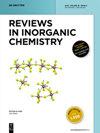Carbon materials derived by crystalline porous materials for capacitive energy storage
IF 3.1
3区 化学
Q1 CHEMISTRY, INORGANIC & NUCLEAR
引用次数: 0
Abstract
The controlled synthesis of precise carbon nanostructures with high electron conductivity, high reaction activity, and structural stability plays a significant role in practical applications yet largely unmet. Metal-organic frameworks (MOFs), covalent organic frameworks (COFs), and coordination polymers (CPs) as crystalline porous materials (CPMs) have shown extraordinary porosity, tremendous structural diversity, and highly ordered pores, offering a platform for precise controlled carbon materials (CMs) with regular porous structures and high performances. Some recent studies have shown that CMs derived from CPMs with high specific surface area, superior chemical stability, excellent electrical conductivity offer a great opportunity for electrochemical energy storage and conversion. In this review, we summarize recent milestones of CPMs derived CMs in the field of capacitive energy storage. We hope the more precise design and control at the atomic level of CPMs could provide us a constructive view of the structure-activity relationship between CMs and electrochemical capacitors, as well as future trends and prospects.用于电容式储能的多孔结晶碳材料
受控合成具有高电子传导性、高反应活性和结构稳定性的精密碳纳米结构,在实际应用中发挥着重要作用,但在很大程度上尚未实现。金属有机框架(MOFs)、共价有机框架(COFs)和配位聚合物(CPs)作为结晶多孔材料(CPMs),已显示出非凡的孔隙率、巨大的结构多样性和高度有序的孔隙,为具有规则多孔结构和高性能的精确可控碳材料(CMs)提供了平台。最近的一些研究表明,由 CPMs 衍生的 CMs 具有高比表面积、优异的化学稳定性和出色的导电性,为电化学能量存储和转换提供了巨大的机遇。在这篇综述中,我们总结了 CPMs 衍生的 CMs 在电容储能领域的最新研究进展。我们希望 CPMs 在原子水平上更精确的设计和控制能为我们提供一个建设性的视角来看待 CMs 与电化学电容器之间的结构-活性关系,以及未来的发展趋势和前景。
本文章由计算机程序翻译,如有差异,请以英文原文为准。
求助全文
约1分钟内获得全文
求助全文
来源期刊

Reviews in Inorganic Chemistry
化学-分析化学
CiteScore
7.30
自引率
4.90%
发文量
20
审稿时长
1 months
期刊介绍:
Reviews in Inorganic Chemistry (REVIC) is a quarterly, peer-reviewed journal that focuses on developments in inorganic chemistry. Technical reviews offer detailed synthesis protocols, reviews of methodology and descriptions of apparatus. Topics are treated from a synthetic, theoretical, or analytical perspective. The editors and the publisher are committed to high quality standards and rapid handling of the review and publication process. The journal publishes all aspects of solid-state, molecular and surface chemistry. Topics may be treated from a synthetic, theoretical, or analytical perspective. The editors and the publisher are commited to high quality standards and rapid handling of the review and publication process.
Topics:
-Main group chemistry-
Transition metal chemistry-
Coordination chemistry-
Organometallic chemistry-
Catalysis-
Bioinorganic chemistry-
Supramolecular chemistry-
Ionic liquids
 求助内容:
求助内容: 应助结果提醒方式:
应助结果提醒方式:


